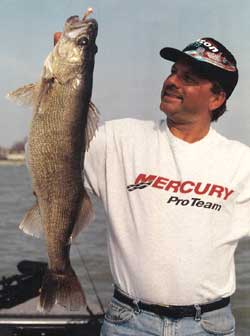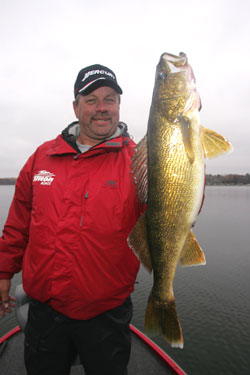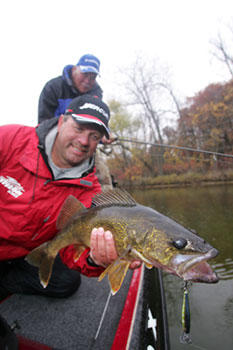
Every angler has a sweet spot.
It’s a place you look forward to visiting every year. It’s a place you share with family and friends. It’s a place where you get away for a few days or a week to unwind and relax.
For many of us, that means heading north to a post-card perfect lake where the water is cold and clear and the fish fat and feisty. However, the painful price of gasoline is forcing many of us to reconsider some of those traditional travel plans.
The answer may well be a river somewhere near your home.
Whether it’s a large flowage like the Mississippi, Missouri or Wisconsin or one of the smaller rivers that can be found all across the Midwest, there is a destination available that can hold its own against any body of water in terms of scenery, recreational options and angling.
In fact, the summer fishing on most of these waterways might just be better than it is on many of the more remote lakes.
Typically, rivers don’t get as much pressure through July and August, but there are still scads of hungry walleye and sauger to be caught, as well as other species like smallmouth bass, largemouth bass, white bass, northern pike, muskies, crappies, bluegills, perch and catfish.
Finding river walleye and sauger this time of year isn’t that difficult, either. Basically, it’s all about structure and locating the proverbial spot on the spot. And because of the warmer water temperatures that summer brings, a fish’s metabolism and activity increase. Thus, they feed more frequently, and that’s always a good situation for an angler.
Presentations can be as simple or complex as you desire. There are a variety of ways to target summer walleye and sauger in river systems, and you can choose a method that will work for any level of angling experience from trolling crankbaits and live bait to still fishing or casting jigs and cranks.
Ask most veteran river anglers and they’ll tell you that wingdams hold the majority of the walleyes through the summer months. Current flow is typically slower this time of year, making it convenient for walleyes to tuck into the rocks and ambush whatever the river brings their way.
Of course, not every wingdam holds fish every day. Some have been covered with silt through the years and don’t provide the security walleyes prefer. Others feature a sharp peak rather than the flat tops that active walleyes like to cruise when they’re actively feeding.

Largely, wingdam fishing is a trial and error experience until you locate fish. Then you can determine what characteristics the dam has that might lead you to others loaded with fish, whether it’s the velocity of the current in that particular spot, the depth of water in front or on top of the dam or its location. In some situations, dams on inside or outside bends in the river channel might be preferred. Sometimes, it might be shorter dams away from boat traffic that are holding walleyes.
In general, the tips of the wingdams tend to be hot spots during periods of low current. When the river is moving more rapidly, look for fish inside the tip along the face of the dam.
And always look for the sweet spot.
It’s been my experience that every dam has one, and that’s where most of the walleyes will be caught. It can be a stretch where the dam has been hit by a barge and the rock is scattered. It can be a high point on top or a pocket that’s slightly deeper than the water around it. It can be an area of scattered boulders in front of the dam.
In late spring when the walleyes first move onto the wingdams, casting crankbaits or jigs is a good way to catch them. I’ve had good success throwing No. 5 and No. 7 Normark Shad Raps, and Fat Raps work well, also. I like these lures because they gain depth during my retrieve, meaning I can cast to the top of the dam and remain in the strike zone as the Raps work down the face. As summer sets in, I’ll cast cranks or jigs early and late in the day during low-light periods, but I spend most of my searching time pulling live bait on three-way rigs in front of the dams. My MinnKota Terrova bow mount with 101 pounds of thrust provides a stealthy approach and enough muscle for any current, and my Optima batteries give me the long-lasting power to fish this way all day long.
I’ve seen anglers employ all kinds of rigs for this approach, including combinations featuring jigs and live bait, jigs and crankbaits and even double crankbaits.
I tend to keep it simple with a pencil sinker and a plain hook or floating jig head on a three-way, although I will substitute an Original Floating Rapala for the live bait when necessary.
There are three reasons for this presentation.
First, I’m targeting active walleyes, and they usually can’t resist a nightcrawler, leech or willow cat wiggling in their face.
Second, I want to be as precise as possible when working structure. I can fish this rig almost vertically, which gives me complete control of where it is and the sensitivity of my Zebco Quantum rods let me know what’s on the bottom at all times.
Third, wingdams are rocky and you are going to lose some tackle. It’s far quicker and less expensive to re-rig a sinker and plain hook than a double-crankbait rig.

I go with slightly longer leader lengths in the summer that get my bait a foot or more off the bottom. Because there is less current than there is at most times of the year, walleyes and sauger don’t have to pin themselves to the bottom to find relief. And because they are more active in general, they’ll come up after a bait much more readily than they will go down to get one.
I don’t do it much, but anchoring up is another good way to work over a wingdam once you’ve located fish. Rig up an in-line sinker only as heavy as is necessary to get down in the current, followed by a barrel swivel and a bait hook or floating jig head. Get far enough upstream of the hot spot to allow you to work a leech, crawler or willow cat across the face. Where two rods per angler are allowed, set one up in a rod holder and work the other one.
Another anchoring option is the deep holes that are present in many sloughs. Current seems to be a must to attract walleyes. If the water’s too stagnant, they simply won’t be there. The same rigs work in these locations, and they can hold some giant walleyes.
Other good casting and three-way rigging locations to look for are the lateral rock that exists in many rivers as shoreline protection, rip-rap and any other rockpiles that break the current and create an eddy. Usually, these spots are easier to fish than wingdams because they are visible. And as with wingdams, find the sweet spot and you’ll always catch more fish.
Trolling crankbaits on lead-core line is a tried and true method for catching summer river walleyes, too. Shad Raps are a good lure choice because they imitate the primary forage in many of these flowages.
Locations vary from the edges of old river channels and sand flats to long breaklines along inside and outside river bends. I rely on my Lowrance 113HD sonar/global positioning unit to help me identify the breaklines and mark them so I can repeat my trolling runs when I contact fish.
Fish will be scattered along these contours, but they use them like we use our interstate highways. I usually start with the inside turns, which tend to be shallower and frame the edges of sand flats. If I don’t find active fish there, I’ll work the outside bends where the dropoff is usually sharper and deeper, especially in cold front situations when walleyes seem to hug sharp structure. Another productive pattern is trolling the tips of wingdams. In many rivers, you can locate a stretch where they line up and create an easy trolling path to follow.
Let out enough colors of lead-core until you can tell by the tip of your rod that the lure is ticking the bottom. Then turn the reel handle three or four turns to get the lure running a foot or so off the bottom.
Don’t be afraid to pick up the speed. I troll as fast as 3-4 mph with my Mercury four-stroke kicker motor, and when I’m dealing with fast current, I’ll even run my Optimax outboard to get my Triton 215X moving. You are competing with a lot of natural forage in the heat of summer, and you’ll often catch more fish by soliciting reaction strikes rather than giving the walleyes a long, clear look at an artificial lure.
In baseball, it’s often the difference between breaking a bat and lining a double to the gap. In golf, it’s the difference between dribbling a shot off the tee and hitting a picturesque drive down the center of the fairway. In fishing, it’s the difference between scratching your head until you develop a sore spot and a rewarding day of battling fish.
It’s all about the sweet spot. And it might be a lot closer to your home than you realize.










